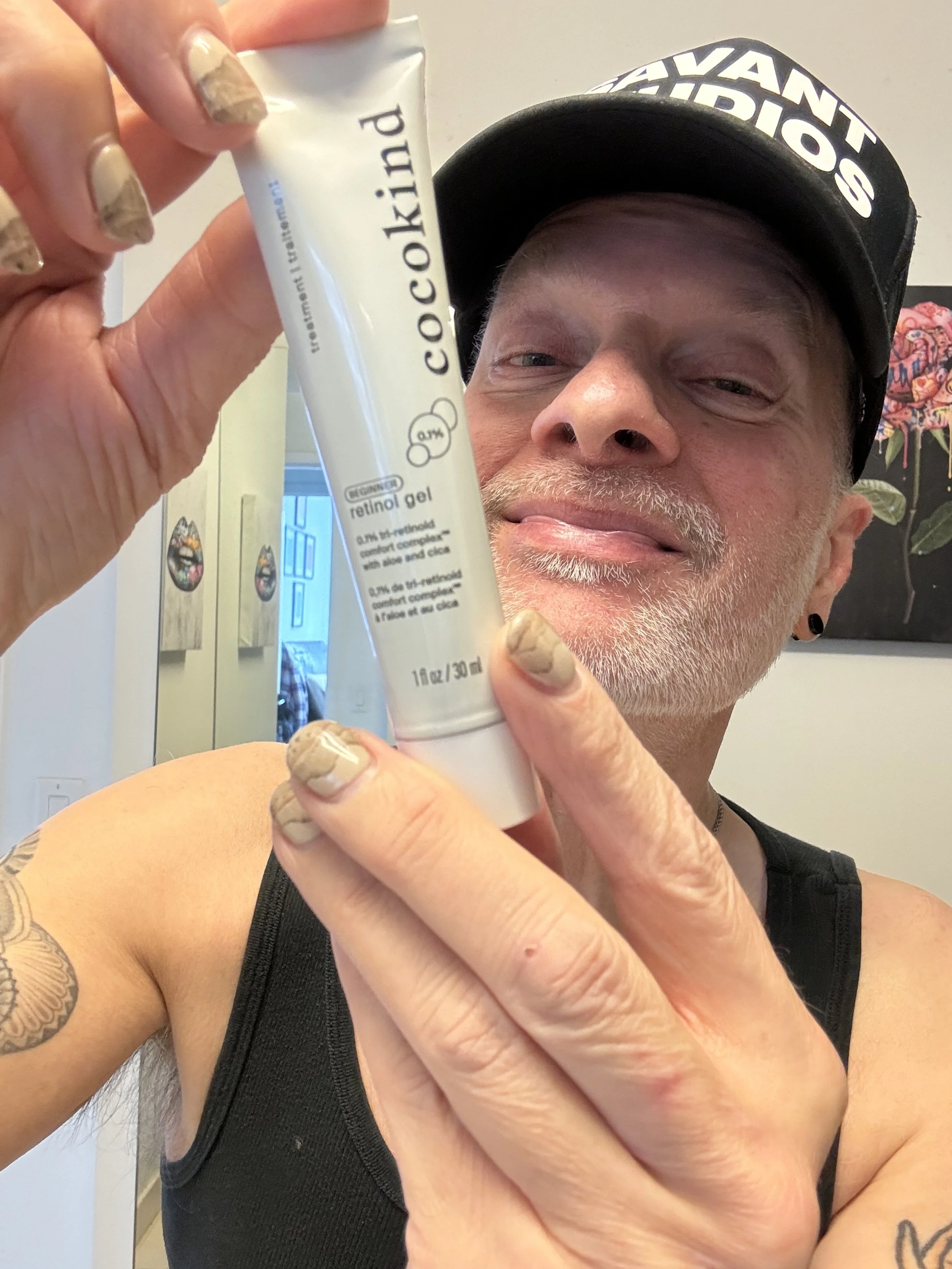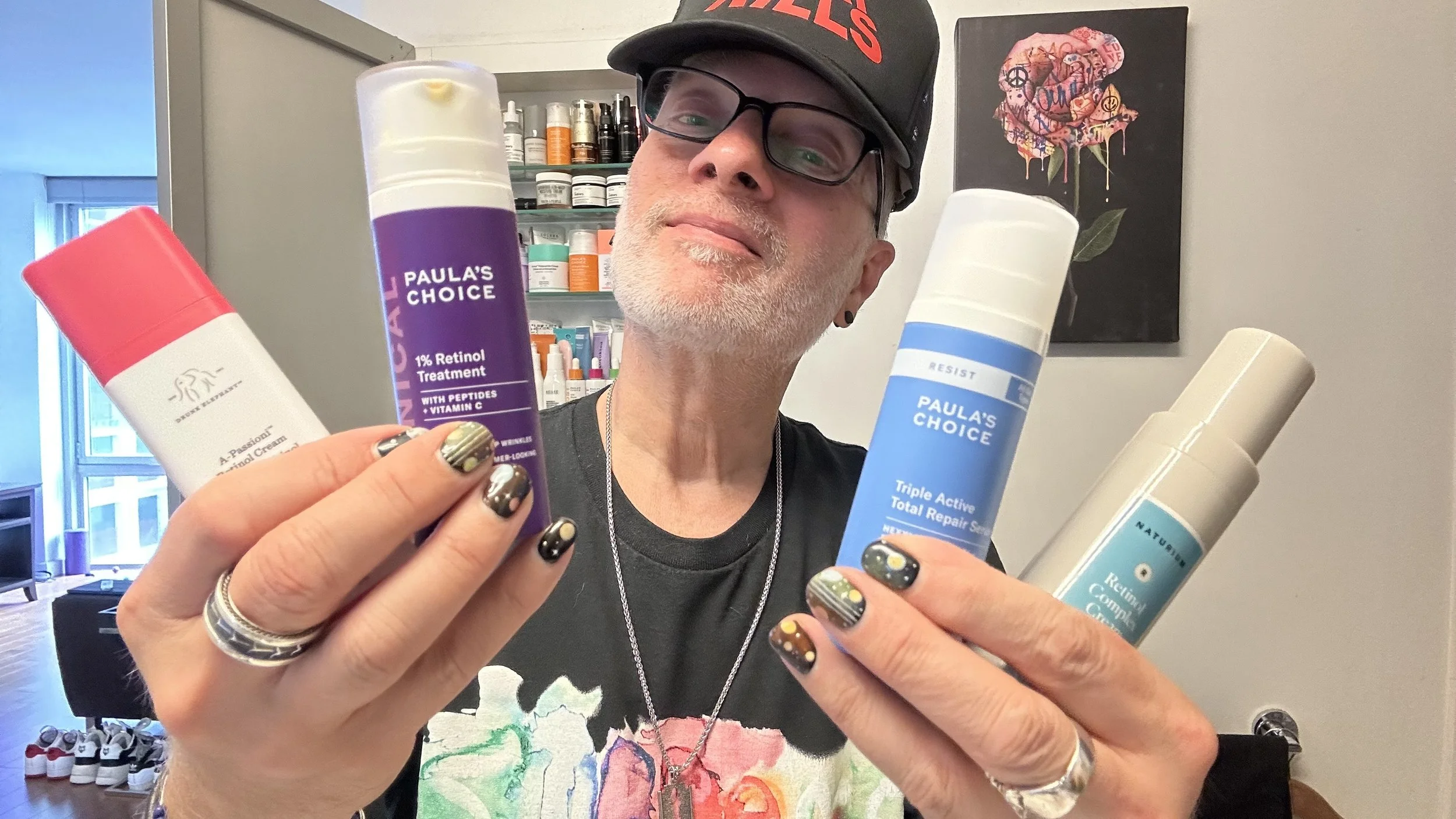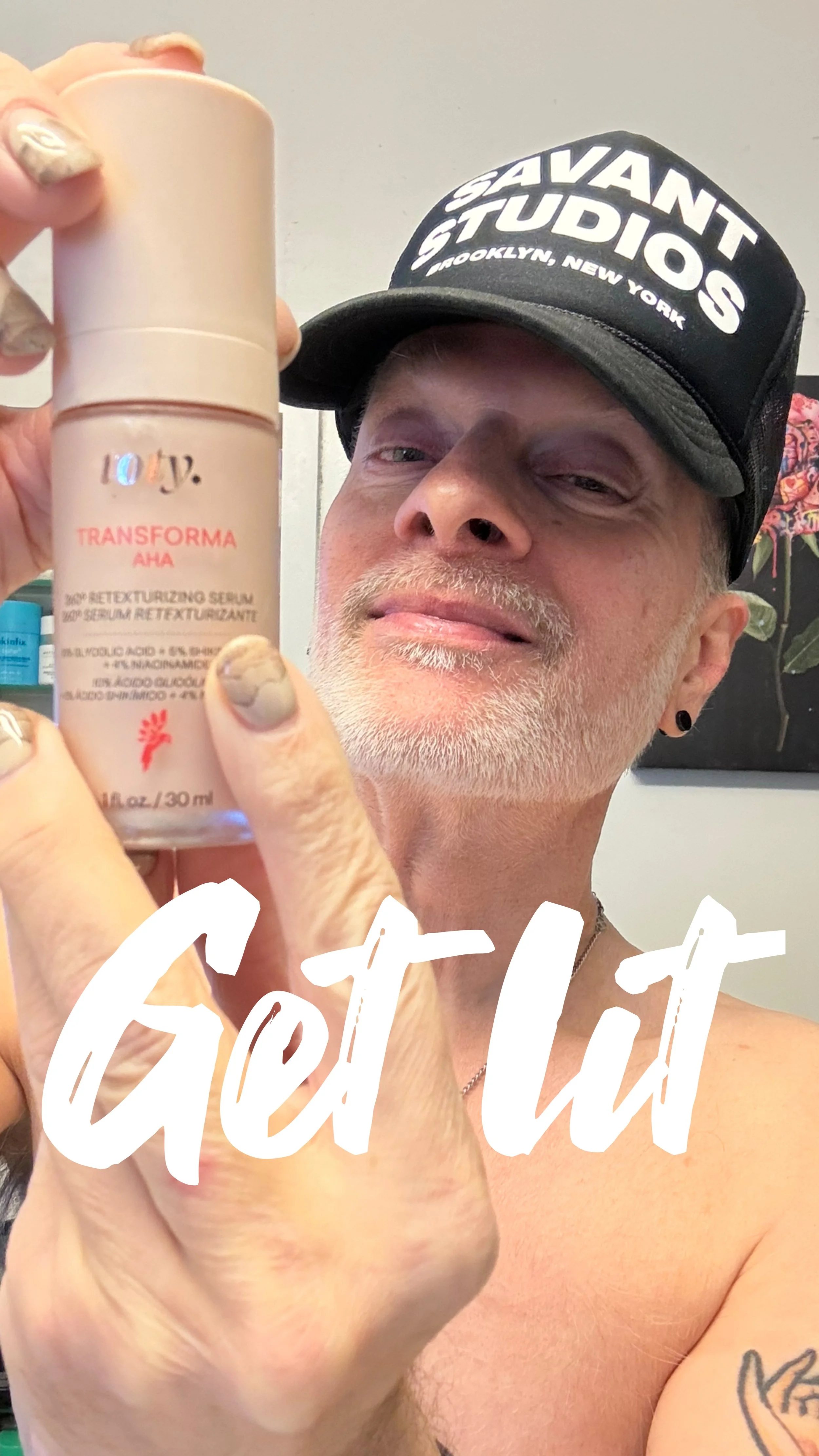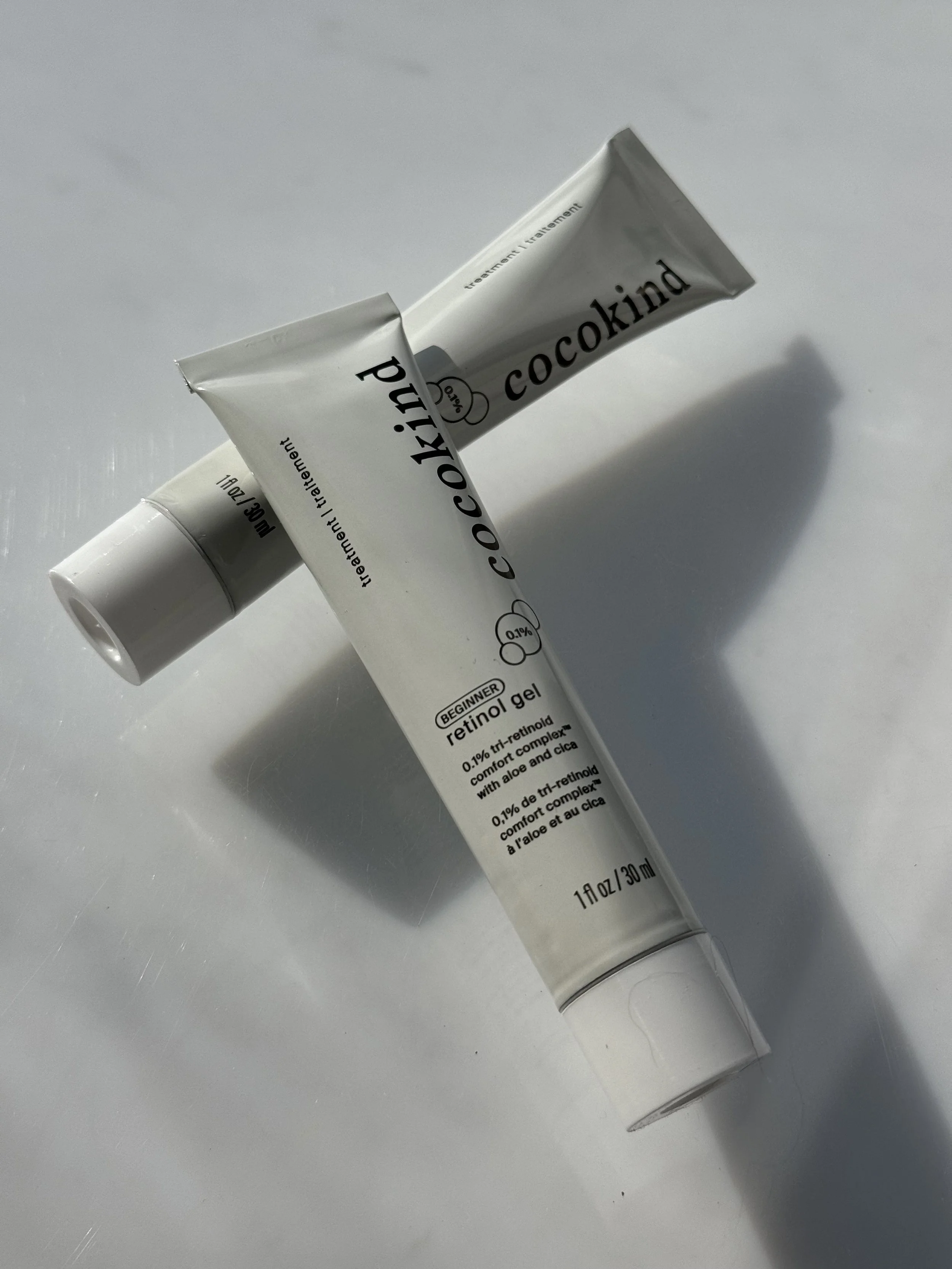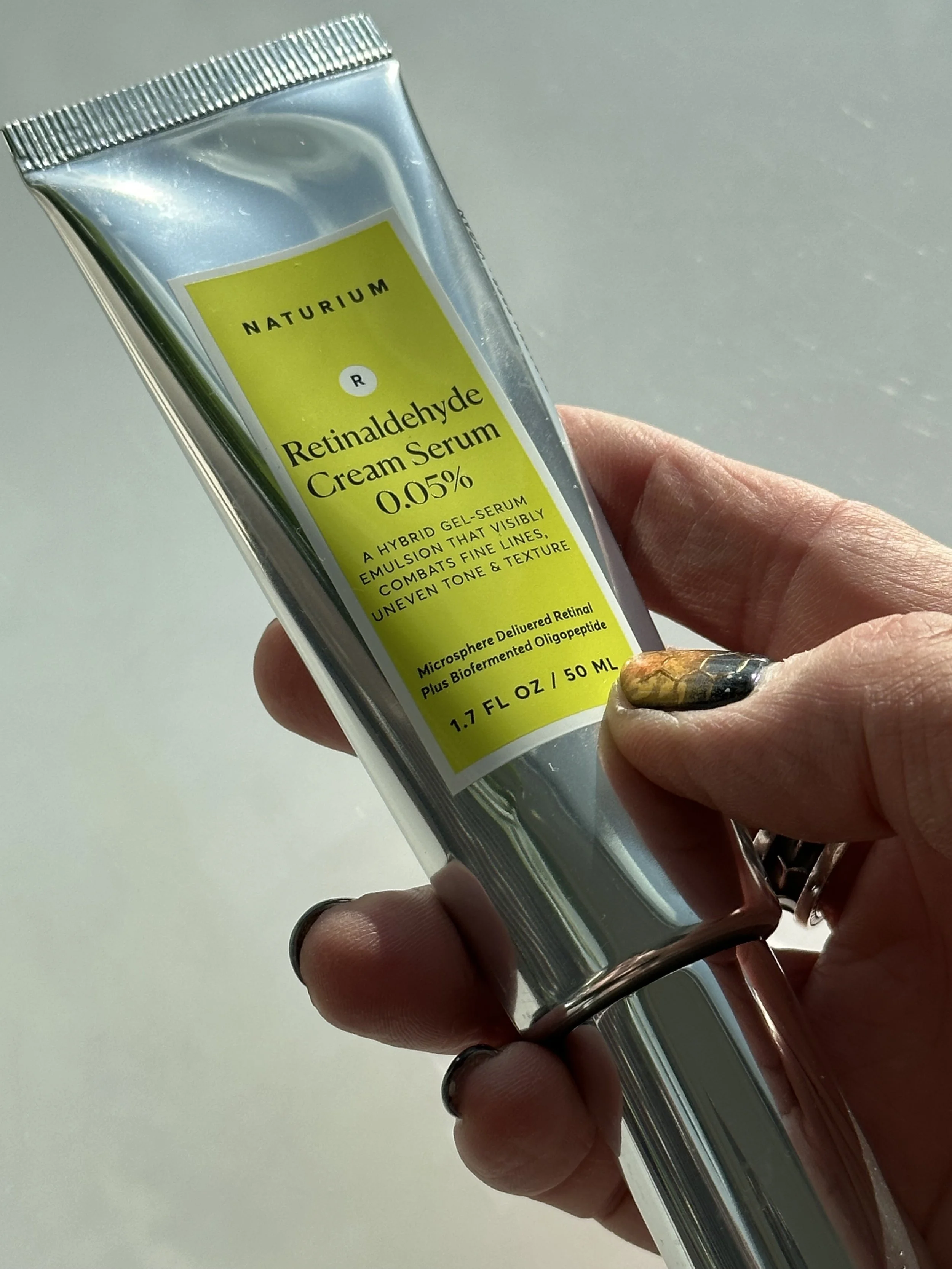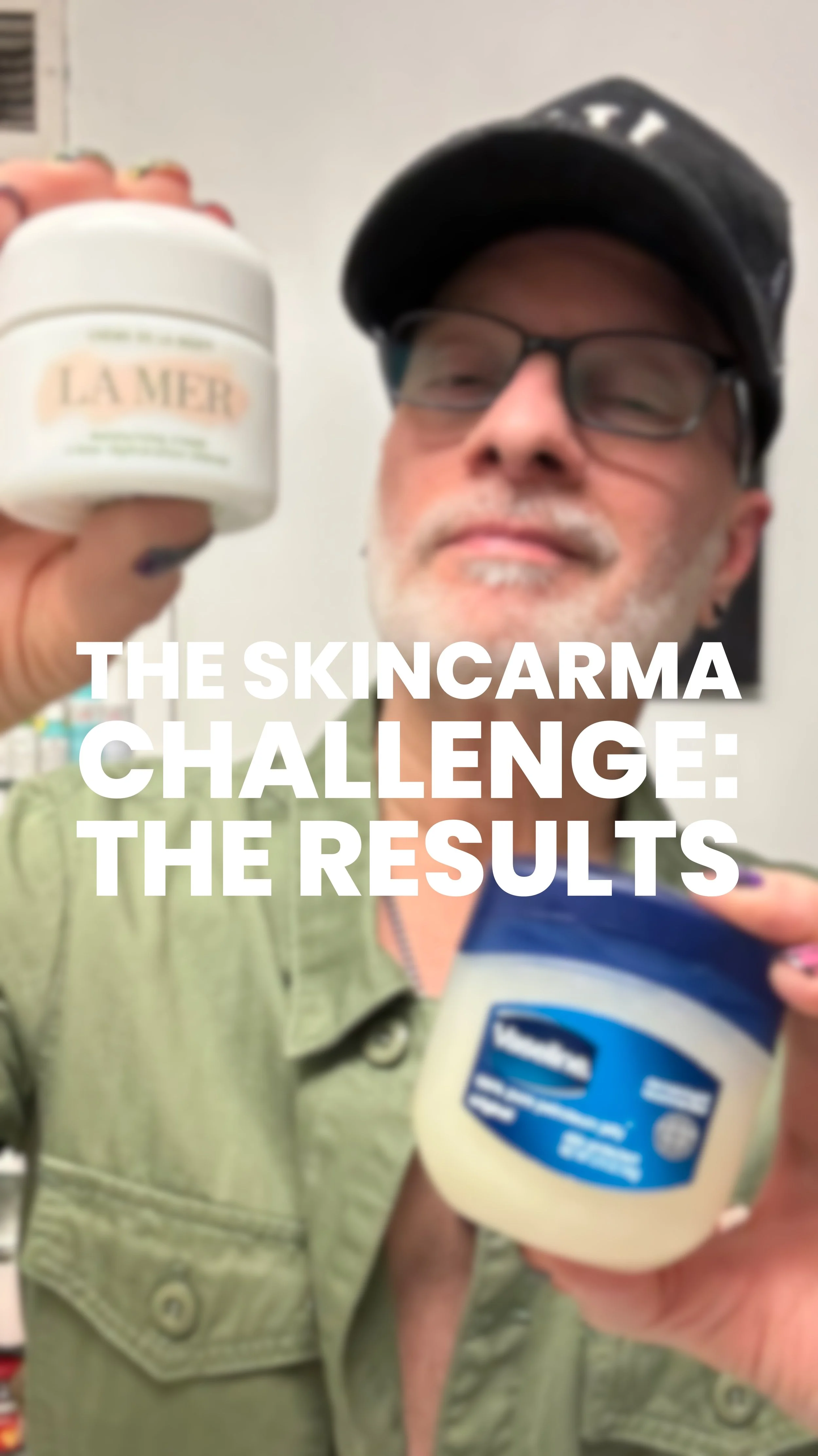PRODUCT REVIEW: COCOKIND BEGINNER RETINOL GEL 0.1% - What retinol should a beginner use? Is 0.1% retinol too strong for beginners? How often should you use retinol when first starting?
COCOKIND BEGINNER RETINOL GEL
I spent a lot of time playing around with retinoids last year and am quite pleased with my compendium of the best Retinol face serums and creams. Those product reviews are available on the blog here.
My Retinol reviews run the gamut – from the mildest Retinol serums for beginners to the most intense Retinol creams for advanced users. And everything in between.
Just starting out? Check out the Paula’s Choice Super Antioxidant Concentrate Serum with Retinol. With .01% Retinol, it’s on the mild side, light and easily layered.
Consider yourself an advanced user? I’m a big fan of the Paula’s Choice CLINICAL 1% Retinol Treatment – the one I reach for when I’m in the mood to do the most. In fact, it was my first-ever experience with Retinol. I didn’t think it was as strong as it is because it wasn’t a prescription retinoid treatment with Tretinoin. That was a big mistake.
Haven’t yet incorporated Retinol into your morning routine? The Paula’s Choice Triple Active Total Repair Serum is the ideal way to kick that off. Wait. Can you use Retinol in the day? Yes. Yes, you can! And this silky serum with 0.3% Retinyl Propionate and 5% Niacinamide is the perfect product for day use. Again, you can catch reviews of all my Retinol faves on the blog here.
One of my favorite skincare brands, Cocokind, hasn’t offered a Retinol treatment until now. I’m a big fan of everything Cocokind does and was super excited to recently test-drive the new Cocokind Beginner Retinol Gel. Indeed, with a 0.1% retinoid complex, it’s among the best retinol products for first time users.
More on this cool new Cocokind formula below…
BEST RETINOL FACE CREAMS AND SERUMS
Truth be told it wasn’t until relatively recently – about two to three years ago – that I made a habit of incorporating Retinol into my regular skincare routine. My skin long ago became accustomed to the powerful anti-aging active and today I never experience any kind of irritation from even the strongest face cream with Retinol.
I’m even good with the Paula’s Choice CLINICAL 1% Retinol Treatment – you know, the one that nearly burned my face off.
Today, Retinol is an essential part of what I refer to as my “ABC” skincare philosophy. The Skincarma ABC method consists of three pro-skin health essentials – a Retinol face serum or cream (the A), a Niacinamide serum (the B) and a Vitamin C serum. I prefer dedicated serums as they are more easily layered and quickly absorbed by the skin.
Whatever your skin’s level of tolerance for Retinol, a retinoid serum or treatment should be a part of your anti-aging skincare routine. The trick is to find one that suits you…
WOW THIS TOTY AHA SERUM IS POTENT!
Before I get into my detailed Cocokind Beginner Retinol Gel product review just below, I wanted to explore some of the most frequently asked questions about Retinol for beginners and the ingredient technology behind Cocokind’s new beginner Retinol…
1. What retinol should a beginner use?
If your skin isn’t accustomed to using Retinol, the key is to start low and go slow. That’s true whether you’re a total beginner who’s never used Retinol, or you’ve slacked off and been inconsistent with it. Either way, it’s recommended to start out with a low concentration of any retinoid. Seek out a product formulated with 0.25% or 0.3% Retinol – or lower. Or, a weaker retinoid molecule than Retinol like Retinol Palmitate.
Many OTC Retinol treatments (those available without a prescription from skincare brands) are made with complexes of various retinoid molecules like Retinol, Retinal, Retinyl Propionate and Retinol Palmitate – considered the weakest of the retinoid molecules.
A newly popular retinoid is Retinaldehyde (Retinal). While Retinaldehyde is stronger and more effective than Retinol, it is available in lower, more tolerable doses that can be suitable for sensitive skin or for those just starting out. Among my favorites of these is the Naturium Retinaldehyde Cream Serum 0.05% – which I review on the blog here.
With any new retinoid product, it’s a wise idea to limit your application to a couple of nights a week for a week or two. Then, work your way up to every other night. As your skin adjusts, you can begin applying it nightly and even graduate to a higher concentration product like the Naturium Retinaldehyde Cream Serum 0.10%.
Explore my picks of the best Retinol face creams and serums on the blog here.
Sources: Medical Dermatology Associates of Chicago: The Beginner's Guide To Retinol; Skincare.com: A Beginner’s Guide to Using Retinol
2. Is 0.1% retinol too strong for beginners?
No, in fact a 0.1% Retinol cream or serum is really the ideal place to start. Even a 0.25% or 0.3% concentration can be considered a beginner Retinol and best for those with a sensitivity for the anti-aging active.
With any Retinol product, no matter the concentration, it’s smart to start low and go slow. (see #1 above)
Among the best Retinol face creams and serums for beginners are the Paula’s Choice Super Antioxidant Concentrate Serum with Retinol and the Naturium Retinol Complex Cream. The Cocokind Beginner Retinol Gel, which I review in full just below, is also an excellent place to start.
Explore my picks of the best Retinol face creams and serums on the blog here.
Sources: Reddit: What matters the most in Retinol, higher percentage or frequency of usage?; Paula’s Choice: What percentage of retinol should I use?
3. How often should you use retinol when first starting?
Whether you're incorporating Retinol into your skincare routine for the first time, or a lapsed user, it’s best to start low and go slow. Everyone’s skin is unique and it’s important to understand that your skin may or may not have an adverse reaction to retinoids. And if it does, it can be mild or severe. It’s all normal!
Start by choosing a Retinol face cream or anti-aging serum with Retinol that has a lower concentration of the active. Both the Paula’s Choice Super Antioxidant Concentrate Serum with Retinol and Naturium’s Retinol Complex Cream are great options for new users.
A smart application strategy is to apply your treatment the first night and see how your skin reacts to it by the morning. Give your skin a day or two to rest before applying it again. Increase application to every other night until you use the product up – over two to three weeks.
Either repurchase the product or “graduate” to a stronger option. Paula’s Choice has a superb collection of Retinol face creams and serums that range from a mild strength of 0.01% to their highest concentration of 1%. You can see the brand’s side by side product comparison here.
Once you’re sure your skin has acclimated and is tolerating the Retinol well, move to nightly application. And, always wear a sunscreen of SPF 30 or higher during the day. Not only is sunscreen the best anti-aging cream in your arsenal, but Retinol use can cause sun sensitivity and accelerate photoaging.
Explore my picks of the best Retinol face creams and serums on the blog here.
Sources: Paula’s Choice: Retinol Skin Care Guide for Beginners
4. What is better retinol or retinal?
Both Retinol and Retinal (also known as Retinaldehyde) are retinoids and derivatives of Vitamin A. Among the best anti-aging ingredients used in OTC anti-aging skincare, each can be effective at promoting cell turnover, stimulating collagen production, and combatting the signs of photoaging such as fine lines, wrinkles, and uneven skin tone.
When comparing Retinol and Retinal, it’s important to consider their efficacy, potency, and molecular interaction with the skin. And, of course, the other actives they’re paired with in a particular product.
The more common of the two, Retinol is generally a milder retinoid molecule than Retinal – though it’s not considered mild relatively speaking. When applied to the skin, Retinol requires conversion to retinoic acid (the active form of vitamin A). This conversion process occurs in two steps: Retinol first converts to Retinaldehyde and then to retinoic acid – which is the active ingredient that works to address signs of skin aging.
Due to this slower, two-step process, Retinol is less potent and somewhat less irritating than Retinal. But, again, concentration matters. A 1% concentration of Retinol can be more irritating to your skin than a lower 0.05% concentration of Retinaldehyde as in Naturium’s Retinaldehyde Cream Serum 0.05%.
In contrast, Retinal (Retinaldehyde) is a conversion step closer to retinoic acid and converts directly to retinoic acid in the skin. This quicker conversion means it can be more effective at promoting collagen production and stimulating cell turnover for faster visible results. It also means it can more easily irritate your skin.
Explore my picks of the best Retinol face creams and serums on the blog here.
Sources: Medik8: Retinal vs Retinol: Which Is Better For Your Skin?; Byrdie: Retinol vs Retinal: What's the Difference?
5. Product Review
Cocokind Beginner Retinol Gel Review
I’ve been a big fan of Cocokind and their clean, well-formulated skincare products for 2-3 years now. Cocokind products are accessibly priced and considered optimal for sensitive skin as they tend to use gentler actives and at more conservative concentrations.
The Cocokind Silk SPF 30 facial sunscreen is among my favorite hybrid sunscreens with both mineral and chemical UV filters. Priced at $25, it’s one of the most affordable, comfortable, and well-formulated sunscreens in my collection – and is often the one I reach for on my early morning bike rides. You can catch my review of it on the blog here.
And the $22 Cocokind Ceramide Barrier Serum is one of the most pleasurable moisturizing serums and among the best face serums with ceramides I’ve come across. It’s easily layered as the last step in the serum phase of your routine to add a boost of deep moisture before sealing everything in with a heavier, occlusive face cream.
So I was really excited to try out the brand’s new Beginner Retinol Gel – a mild anti-aging serum with a 0.1% complex of three distinct retinoid molecules.
PRODUCT REVIEW: PAULA'S CHOICE CLINICAL 1% RETINOL TREATMENT
It’s those three retinoid molecules in combination that give the Beginner Retinol Gel its oomph despite its milder formulation – classic Cocokind.
The brand’s trademarked Tri-Retinoid Comfort Complex™ is a blend of 0.05% Retinol, 0.025% Retinal, and 0.025% Granactive Retinoid – also known as HPR, or Hydroxypinacolone Retinoate.
Psst…HPR is the retinoid molecule behind The Ordinary’s two classic Retinol serums – the Granactive Retinoid 5% in Squalane and the milder 2% in Squalane.
The strongest of the three retinoids in the Cocokind blend is Retinal (Retinaldehyde), which converts to Retinoic Acid more quickly in the skin for enhanced efficacy. The brand refers to the molecule’s conversion process as “time-released,” though that’s just a marketing term to imply that the serum is gentler on the skin.
I don’t know if that really makes any difference. The important point is that the 0.025% Retinal drives the product’s efficacy. And, that the serum features a blend of soothing actives that help to mitigate against the irritation and dryness common to Retinol use – what deters most people from using Retinol.
Most notably, to help hydrate and soothe the skin, there’s approximately 5% Glycerin, Aloe Leaf Extract and Centella Asiatica Extract – the hydrating, soothing antioxidant powerhouse known as “cica”. It’s at about an active 2% concentration according to a detailed formula analysis from What’s in My Jar.
Emollient plant oils include Squalane, Caprylic/Capric Triglyceride and Soybean Oil. Though relatively lightweight, these give the serum a denser, milkier texture that helps to moisturize the skin. Despite the smattering of oils, the product is quite lightweight, easy to layer and quickly absorbed.
As an experienced Retinol user, I can’t say whether it would cause noticeable irritation in people with extreme sensitivity to Retinol. But, I have tempted fate by applying it as an eye treatment on multiple evenings and seen no irritation in my delicate eye area! Because it’s so light, and formulated to go easy on the skin, I think it’s great to add a bit to an eye cream.
Whether you’re just starting out, or have had a tough time with Retinol in the past, at $27 Cocokind’s Beginner Retinol Gel is worth a try.
6. Pros & Cons
What I like about it: The Cocokind Beginner Retinol Gel is a relatively mild Retinol serum, though it’s got some oomph to it. I like that it relies on lower concentrations of three of the most effective retinoids, rather than a weaker molecule like Retinyl Palmitate. This assures that a user will actually see real results more quickly. Its light, silky texture means it’s easily layered. Hey, it makes a great addition to an eye cream, too!
What I don’t like about it: I like everything about it.
Who it’s for: All skin types, especially sensitive skin.
SHOP THE BLOG: Want to try it for yourself? Purchase the Cocokind Beginner Retinol Gel for $27 here.
The Ingredient List of the Cocokind Beginner Retinol Gel:
 sii|h 0 0, Hydroxyethyl Acrylate/Sodium Acryloyldimethyl Taurate Copolymer vc, Caprylic/Capric Triglyceride emo, Coco-Caprylate/Caprate emo, Fructooligosaccharides h, Aloe Barbadensis Leaf Extract
sii|h 0 0, Hydroxyethyl Acrylate/Sodium Acryloyldimethyl Taurate Copolymer vc, Caprylic/Capric Triglyceride emo, Coco-Caprylate/Caprate emo, Fructooligosaccharides h, Aloe Barbadensis Leaf Extract  so|emo|h, Squalane
so|emo|h, Squalane  sii|emo 0 1, Pentylene Glycol solv|h, Retinol
sii|emo 0 1, Pentylene Glycol solv|h, Retinol  cci, Hydroxypinacolone Retinoate
cci, Hydroxypinacolone Retinoate  cci, Retinal
cci, Retinal  cci, Tocopherol
cci, Tocopherol  aox 0-3 0-3, Centella Asiatica Extract
aox 0-3 0-3, Centella Asiatica Extract  so|aox|h, Allantoin
so|aox|h, Allantoin  so 0 0, Beta Vulgaris (Beet) Root Extract
so 0 0, Beta Vulgaris (Beet) Root Extract  aox|h, Glycine Soja (Soybean) Oil
aox|h, Glycine Soja (Soybean) Oil  emo|perf 0 3, Sodium Hyaluronate
emo|perf 0 3, Sodium Hyaluronate  sii|h 0 0, Tamarindus Indica Seed Polysaccharide, Caprylyl Glycol h|emo, Potassium Lactate buff|h, Cellulose vc, Dimethyl Isosorbide solv|vc, Hexylene Glycol solv|emu|perf|surf 0-1 0-2, Propanediol solv|h, Tetrasodium Glutamate Diacetate chel, Lactic Acid
sii|h 0 0, Tamarindus Indica Seed Polysaccharide, Caprylyl Glycol h|emo, Potassium Lactate buff|h, Cellulose vc, Dimethyl Isosorbide solv|vc, Hexylene Glycol solv|emu|perf|surf 0-1 0-2, Propanediol solv|h, Tetrasodium Glutamate Diacetate chel, Lactic Acid  exf|h|buff, Phenoxyethanol pres, Ethylhexylglycerin pres, Citric Acid buff, Sodium Hydroxide buff
exf|h|buff, Phenoxyethanol pres, Ethylhexylglycerin pres, Citric Acid buff, Sodium Hydroxide buffPRODUCT REVIEW: NATURIUM RETINALDEHYDE CREAM SERUM 0.05%
IS IT REALLY A SCAM?
Find out on my TikTok channel.
WATCH MY VIDEO REVIEW
THE BEST NIACINAMIDE SERUMS FOR CLOGGED PORES AND A BRIGHTER COMPLEXION
ON MY YOUTUBE CHANNEL HERE
WATCH MY VIDEO REVIEW OF
SKINCARE HACKS: GLYCOLIC ACID IS THE NATURAL DEODORANT THAT WORKS!
ON MY YOUTUBE CHANNEL HERE
WATCH MY VIDEO REVIEW OF
MY FAVORITE HUMECTANT SERUMS FROM PAULA'S CHOICE, THE INKEY LIST, GHOST DEMOCRACY AND MORE
ON MY YOUTUBE CHANNEL HERE
WATCH MY VIDEO REVIEW
COOL CLEAN FACIAL SUNSCREENS TO KEEP US SAFE AND SMILING IN THE SUN!
ON MY YOUTUBE CHANNEL HERE
WATCH MY VIDEO REVIEW
THE OPULUS BEAUTY LABS RETINOL SYSTEM – THE COOLEST RETINOL INNOVATION I’VE EVER SEEN
ON MY YOUTUBE CHANNEL HERE
WATCH MY VIDEO REVIEW OF
MY WINTER SKIN SAVIOR: SKINFIX BARRIER+ LIPID REPLENISHING SKINCARE
ON MY YOUTUBE CHANNEL HERE
WATCH MY VIDEO REVIEW
A COMPLETE K-BEAUTY ROUTINE WITH THE BEST FACIAL SKINCARE FROM PURITO, COSRX, MISSHA & MORE!
ON MY YOUTUBE CHANNEL HERE
WATCH MY VIDEO REVIEW
THE YEAR’S BEST VITAMIN C SERUMS WITH PAULA'S CHOICE, SUNDAY RILEY, THE INKEY LIST AND MORE!
ON MY YOUTUBE CHANNEL HERE
WATCH MY VIDEO REVIEW OF
A SELFCARE SUNDAY NOT FOR THE FAINT OF HEART – WITH THE PAULA’S CHOICE 25% AHA PEEL!
ON MY YOUTUBE CHANNEL HERE



